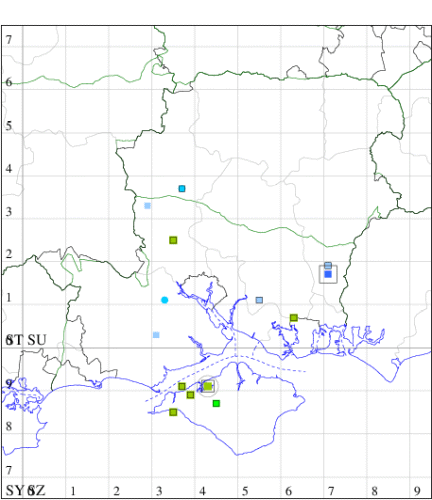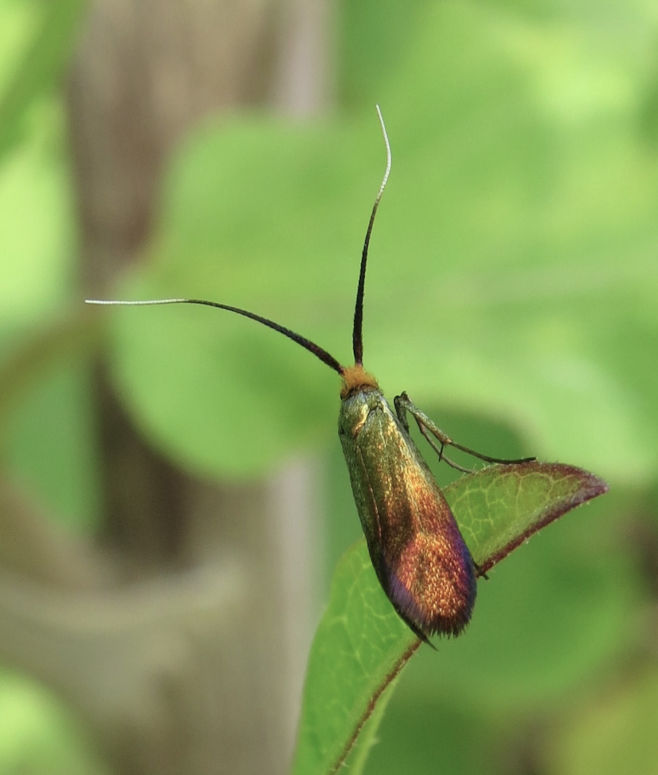Nemophora cupriacella
Checklist Number07.003 [B&F: 0146]
Verification
Record will normally be accepted but photo evidence may be required - check with CMR if not sure of identity
Nationally scarce (Nb) in dry grassland and on downland throughout much of England; rare in Wales and Ireland. While still very rare, in recent years it has been found occasionally in the north-west of the Isle of Wight and sporadically in south Hampshire. Not recorded from North Hampshire for over forty years, one being found at Bramshill in 2020 (and not reported until 2023) was a major surprise.
Wingspan 12-16 mm. This species is parthenogenetic, reproducing asexually with males absent. Identification features include reddish yellow head coloration; yellow hairs on the palps; antenna base thickened with deep-blue scales, white antennae tips; thorax shiny greenish copper shiny, apex of wings notably retracted, golden, with basal half noticeably lighter.
Larva feeds on seeds of Devil's-bit Scabious, Field Scabious and Small Scabious, subsequently feeding in the fallen leaves, living within a movable case.
Wingspan 12-16 mm. This species is parthenogenetic, reproducing asexually with males absent. Identification features include reddish yellow head coloration; yellow hairs on the palps; antenna base thickened with deep-blue scales, white antennae tips; thorax shiny greenish copper shiny, apex of wings notably retracted, golden, with basal half noticeably lighter.
Larva feeds on seeds of Devil's-bit Scabious, Field Scabious and Small Scabious, subsequently feeding in the fallen leaves, living within a movable case.


The abundance in each month is indicated as follows:
 No records
No records Very occasional
Very occasional Irregular
Irregular Uncommon
Uncommon Off-peak, but not unusual
Off-peak, but not unusual Off-peak, but not unusual
Off-peak, but not unusual Main flight time
Main flight time| J | F | M | A | M | J | J | A | S | O | N | D | |
|---|---|---|---|---|---|---|---|---|---|---|---|---|
| Adult |  |  |  |  |  |  |  |  |  |  |  |  |
| Larval |  |  |  |  |  |  |  |  |  |  |  |  |
Records by week (adult)
Records by week (larval)
VC10 Isle of Wight
| Site | Date | Quantity | Recorder | Stage |
|---|---|---|---|---|
| Monkham Copse (SZ48) | 05/08/2006 | one | Sam Knill-Jones, Tim Norriss | Adult |
| Cranmore (SZ38) | 23/07/2014 | one | Martin C Harvey | Adult |
| Ningwood Common (SZ38) | 23/07/2014 | one | Martin C Harvey | Adult |
| Walter's Copse (SZ49) | 08/08/2014 | one | Stephen Plummer | Adult |
| Newtown Meadows (SZ49) | 08/07/2015 | one | Phil Barden | Adult |
| Bouldnor Copse (SZ39) | 11/08/2015 | one | Natalie Bone | Adult |
| Walter's Copse (SZ49) | 27/08/2015 | one | Stephen Plummer | Adult |
VC11 South Hampshire
| Site | Date | Quantity | Recorder | Stage |
|---|---|---|---|---|
| Brockenhurst (SU30) | 1920 | - | Digby | Adult |
| Broughton Down (SU23) | 1971 | - | D W H Ffennell | - |
| Oxenbourne Down (SU71) | 18/08/1972 | one | Richard J Dickson | Adult |
| Botley Wood (SU51) | 12/08/1974 | one | Richard J Dickson | Adult |
| Ashurst, NF (SU31) | 03/08/1985 | - | J R Langmaid, D H, M J Sterling | Adult |
| Oxenbourne Down (SU71) | 14/07/1998 | six | J R Langmaid, I R Thirlwell | Adult |
| Portsdown (SU60) | 22/07/2011 | one | Richard J Dickson | Adult |
| Timsbury (SU32) | 03/07/2015 | one | Tony Rackham | Adult |
| Stubbington (SU50) | 01/07/2018 | one | Dan Houghton | Adult |
VC12 North Hampshire
| Site | Date | Quantity | Recorder | Stage |
|---|---|---|---|---|
| Harewood Forest (SU44) | 02/07/1974 | one | David Appleton | Adult |
| Leckford Estate (SU33) | 1980 | one | D H Sterling | Adult |
| Bramshill Plantation (SU76) | 07/07/2020 | one | Tom Walker | Adult |



